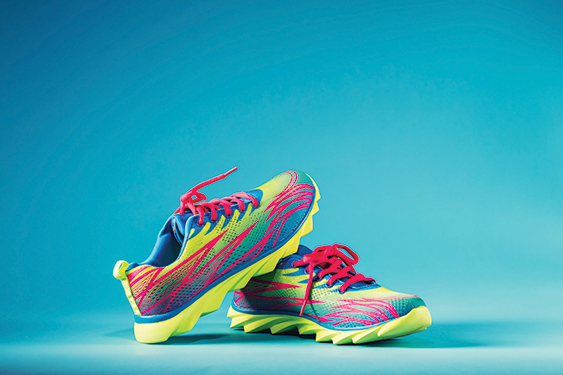Expert Tips on Footwear and Selecting a Better Shoe for Happier, Healthier Feet
by MARY TOOTHMAN
There are 26 bones and 33 joints in the human foot and ankle, and the height of arches and the shape of the toes vary from person to person.
And according to the American Orthopaedic Foot & Ankle Society (aofas.org), the number of potential aches, pains, and pediatric problems is also quite high. While it’s often important to seek professional care for troubles with your feet, there are also many methods of self-care that can help keep feet functioning well.
One important factor is the choice of shoes. The correct shoe size and type can make a world of difference, just as the wrong type or size can bring on pain and problems.
TIPS ON BUYING SHOES
- Timing matters. Always shop at the end of the day; feet naturally expand with use during the day.
- Look for a good fit; shoes that are comfortably loose when worn with soft, absorbent socks.
- Look for a shoe that is shaped like the foot; broad and spacious in the toe area, and comfortable the moment you put them on.
- Take a tracing of your foot with you. Place shoes you are interested in buying on top of the tracing. If the shoe is narrower or shorter than the tracing, do not even try it on.
- Wear the same type of socks to the store that you intend to wear with the shoes.
- Have a salesperson measure both feet; get measured every time you buy new shoes. Feet change with age, often growing larger and wider. If one foot is larger than the other, buy a size that fits the larger foot.
- Stand in the shoes. Press gently on the top of the shoe to make sure you have about a half-inch of space between your longest toe and the end of the shoe. This provides enough room for your foot to press forward as you walk. Wiggle your toes to make sure there’s enough room.
- Do not buy shoes with the idea that they just need to be “broken in.” Find shoes that fit from the start.
- Feel the inside of the shoes to see if they have any tags, seams, or other material that might irritate your foot.
- Examine the soles. Are they sturdy enough protect your feet from sharp objects? Do they provide any cushioning? Try to walk on hard surfaces as well as carpet to see how the shoe feels on both.
It may be a good option to check out a store such as FITniche here locally, where expert advice about shoe selection comes with the purchase. FITniche is a specialty running store with locations in Lakeland, Brandon, and Wesley Chapel. The stores serve a customer base of runners and walkers— and staff provides knowledge about walking, running, shoes, and other products including injury prevention, good form, and even beginning training principles.
A custom fitting is provided for each customer to relieve and prevent pain and common injuries. The stores cater to walkers, runners, triathletes, swimmers, cross-fit enthusiasts or non-exercisers who want to get started.
Sources:
American Orthopaedic Foot & Ankle Society
Harvard Health Publishing:10 Tips for finding the right shoe
